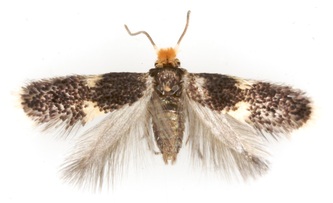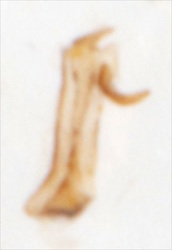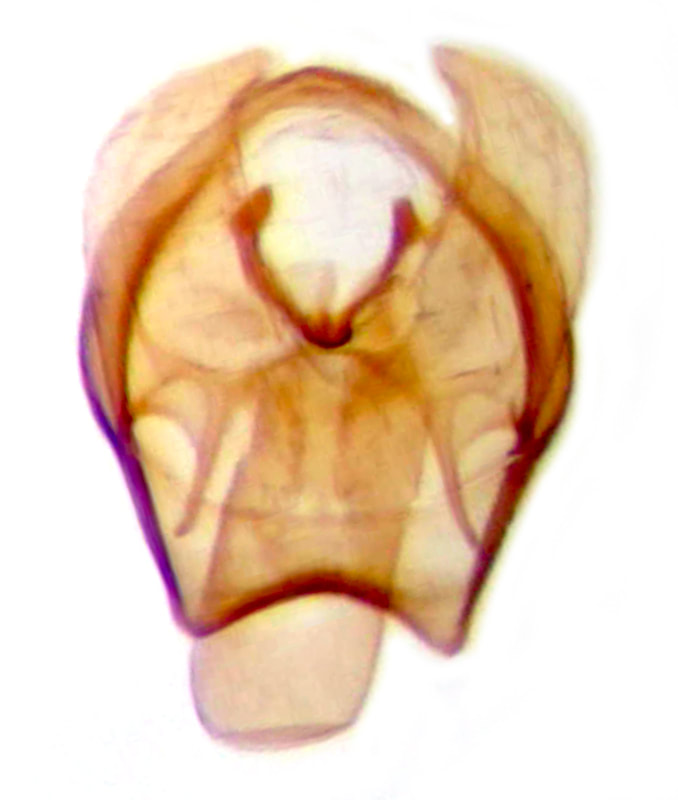|
NEPTICULIDAE : Nepticulinae : Trifurculini
|
04.090 Ectoedemia subbimaculella (Broken-barred Oak Dot)
ws: 5-6mm; Jun-Jul; leaf mine in oak (Quercus spp) Oct-Dec; common in SE.England
ID: Forewing with pale costal and dorsal spots; terminal cilia abruptly white distal to a line of dark-tipped scales; with a pale basal patch that does not occupy the whole basal 1/3 (and may be inconspicuous); without a broad white fascia > E.subbimaculella/heringi. According to MBGBI1 crown usually ferruginous in E.subbimaculella, fuscous in E.heringi; and E.heringi also tends to have a larger white basal patch and all the white areas are whiter than in E.subbimaculella; the hindwing of E.heringi is paler than than that of E.subbimaculella. E.albifasciella is separated in the key by the absence of a basal patch. The text in MBGBI1 states "it is difficult to differentiate the two species with certainty without examination of the genitalia". Nieukerken gives differences in size and number of antennal segments (see table). Before the site became corrupted Nepticuloidea.info gave the frontal tuft colour of E.heringi as ferruginous and of E.subbimaculella as yellow-orange - and this seems more accurate than MBGBI1
Male and female genitalia of all three species are illustrated in MBGBI1 p201; males of all three and females of E.albifasciella and E.subbimaculella are shown at dissection group.
Male genitalia: uncus acutely rounded and gnathos 'W'-shaped in E.subbimaculella; uncus obtusely rounded and gnathos 'U'-shaped in E.heringi.
Female genitalia: although there are differences between E.subbimaculella and E.heringi in the way the apophyses and signa are drawn in MBGBI1 it is clear from Nieukerken that these differences are fanciful - the only true difference, according to Nieukerken, is in the width and number of convolutions in the ductus spermathecae 2-2¼ narrow in E.heringi, 2¼-2½ wider in E.subbimaculella (and I have substantial doubts about whether this can be reliably determined, by me at any rate).
E.subbimaculella is by far the most common Nepticulid at light. E.heringi may be suspected by a darker head, and number of antennal segments may be the most reliable means of confirmation.
Male and female genitalia of all three species are illustrated in MBGBI1 p201; males of all three and females of E.albifasciella and E.subbimaculella are shown at dissection group.
Male genitalia: uncus acutely rounded and gnathos 'W'-shaped in E.subbimaculella; uncus obtusely rounded and gnathos 'U'-shaped in E.heringi.
Female genitalia: although there are differences between E.subbimaculella and E.heringi in the way the apophyses and signa are drawn in MBGBI1 it is clear from Nieukerken that these differences are fanciful - the only true difference, according to Nieukerken, is in the width and number of convolutions in the ductus spermathecae 2-2¼ narrow in E.heringi, 2¼-2½ wider in E.subbimaculella (and I have substantial doubts about whether this can be reliably determined, by me at any rate).
E.subbimaculella is by far the most common Nepticulid at light. E.heringi may be suspected by a darker head, and number of antennal segments may be the most reliable means of confirmation.
fw (mm) |
antennal segments ♂ |
antennal segments ♀ |
|
E.albifasciella |
2.3 - 3.0 |
34-41 |
25-28 |
E.subbimaculella |
2.1 - 2.8 |
31-36 |
24-29 |
E.heringi |
1.9 - 2.4 |
29-32 |
22-25 |
|
§1 Strumpshaw Fen, Norfolk; 29/06/2012; female; fw 2.9mm
§2 Strumpshaw Fen, Norfolk; 29/06/2012; male §3 Strumpshaw Fen, Norfolk; 29/06/2012; male §4 Strumpshaw Fen, Norfolk; 29/06/2012; female §5 Sutton Fen, Norfolk; 05/09/2009; male; fw 2.8mm §6 Westcliff-on-sea, Essex; 15/07/2014; female §7 Westcliff-on-sea, Essex; 15/07/2014; male §8 Westcliff-on-sea, Essex; 04/07/2018; female; fw 2.3mm §9 Westcliff-on-sea, Essex; 04/07/2018; male; fw 2.6mm All images © Chris Lewis |
§10 Pound Wood, Essex; 30/06/2019
§11 Orlestone Forest, Kent; 17/06/2020; female; fw 2.5mm §12 Orlestone Forest, Kent; 24/06/2020; female; fw 2.7mm §13 Orlestone Forest, Kent; 24/06/2020; male; fw 2.4mm §14 Orlestone Forest, Kent; 24/06/2020; male; fw 2.6mm |
Page published 13/02/2013 (§1-5) | Text amended 19/07/2014 | §6&7 added 21/07/2014 | §8&9 added 25/04/2019 | §10 added 21/02/2020 |
§11 added and text amended 05/07/2020 | §12-14 added 27/01/2021
§11 added and text amended 05/07/2020 | §12-14 added 27/01/2021











































